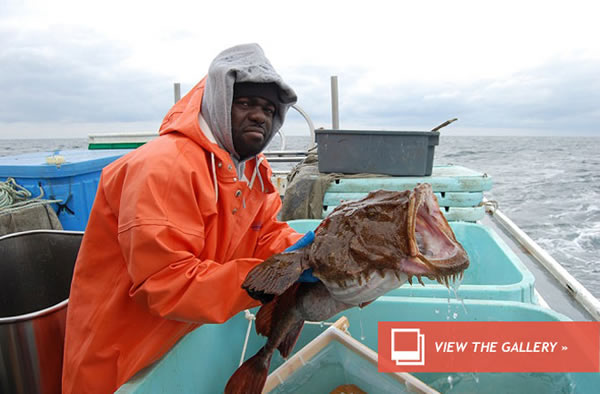Badass Fish Eats Puffins
There’s no getting away from it: your average monkfish looks seriously badass. To all intents and purposes it’s just one giant head, supported by an after-thought of a body and capped with a cavernous mouth fringed with razor-sharp teeth. If that isn’t the kind of thing to keep you awake at night, you’re a braver person than me. Or possibly another monkfish.
Also known as the goosefish, these bottom-dwelling Atlantic fish use their pectoral fins to ‘walk’ along the seabed until they find a spot to their liking, at which point they half-bury themselves in the sediment and use a fishing ‘lure’ at the end of a long antenna to tempt potential prey to their fate.
But when New England fishermen began finding the remains of birds called dovekies (Arctic seabirds that are the smallest members of the puffin family) in the stomachs of monkfish they had caught – well, that was something of a surprise. For one thing, although predation of birds by fish (or, for that matter, by cephalopods) is not without precedent, there remains little understanding of how frequently it occurs.
Badass Fish Eats Puffins
Stomach studies of New England fish caught on research cruises show that spiny dogfish, Atlantic herring, pollock, Atlantic cod, red hake, and fourspot flounder also eat birds; and it’s reasonable to infer that something called the goosefish might have avian tastes. But monkfish generally feed at depths well outside the range of dovekies, which can dive to about 100 feet in pursuit of small fish, crustaceans and zooplankton.
In an attempt to figure out what was happening, scientists with NOAA’s Northeast Fisheries Science Center (NEFSC) and the United States Geological Survey’s Patuxent Wildlife Research Center tagged monkfish to study their movements, and found that, on occasions, goosefish in fact will swim up to near-surface waters at night – either to spawn or to take advantage of ocean currents they use to migrate onshore or offshore. It is unlikely that they actively seek out dovekies when they do so, but rather that the birds, diving for their food, are attracted by the fishes’ lures and swim to their doom. In other words, for dovekies it’s a case of being in the wrong place at the wrong time.
It’s possible, notes lead researcher Matthew Perry of USGS, that other birds get out of Dodge each evening to avoid the prospect of becoming goosefish food.
“I was studying long-tailed ducks and thought, to avoid being eaten, these birds fly 30 to 50 miles to Nantucket Sound each night and return to the ocean in the morning,” Perry said in a press release announcing the findings, which are published in the online journal Northeastern Naturalist. “People ask why don’t dovekies fly to Nantucket Sound at night like the long-tailed ducks to avoid goosefish? My explanation is that dovekies have small wings and can’t make the routine flight.”
Apr 12, 2013 04:16 AM ET by Kieran Mulvaney












